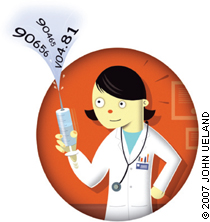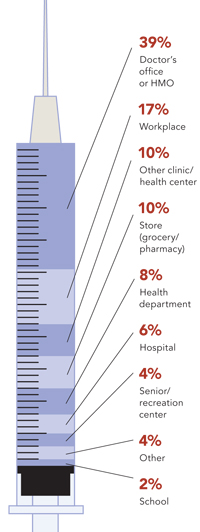
Make this hectic time of year a little smoother by reminding yourself and your staff how to code flu shots.
Fam Pract Manag. 2007;14(9):35-38
Cindy Hughes is the coding and compliance specialist for the AAFP and is a contributing editor to Family Practice Management. Author disclosure: nothing to disclose.

With health officials expanding their flu shot recommendations to cover more age groups and with a record 132 million doses of flu vaccine expected to be available for the upcoming flu season, it's a busy time of year for family medicine practices everywhere.1 Once flu season hits, there's rarely time to stop and look up the fine points of coding flu shots. So as you prepare to provide this preventive service to your patients, take some time today to review the administration, diagnosis and vaccine codes for reporting flu shots. And if you're thinking, “Before I worry about vaccine coding, I need to make sure I'm going to get my vaccine supply,” please see “A word about vaccine supply.”
Administration codes: CPT
CPT codes for vaccine administration are accepted by most payers other than Medicare (which has its own code – more on that later). Selection of the appropriate code is based on three things: the age of the patient, whether the physician counsels the patient or the patient's family about the vaccine, and how the vaccine is administered.
For children younger than 8 years, CPT codes 90465 and 90466 are used to report vaccine administration by injection when the physician counsels the patient or the patient's family. Code 90465 is reported when the first vaccine administration is by injection, and code 90466 is reported for each additional vaccine injection. Codes 90467 and 90468 are reported if a child younger than 8 years is administered a vaccine by intranasal or oral route with physician counseling. Code 90467 is reported when the first vaccine administered is intranasal or oral, and code 90468 is reported for each additional vaccine administered by these methods.
Codes 90471 and 90472 are reported for flu vaccine injections when no physician counseling is provided at the time of vaccine administration or when vaccines are administered to persons older than 8 years who are not Medicare beneficiaries. Code 90471 is reported when the first vaccine is administered by injection, and code 90472 is reported for each additional vaccine injection. Codes 90473 and 90474 are reported when providing vaccines to these patients by intranasal or oral routes. Code 90473 is reported when the first vaccine administration is by intranasal or oral route, and code 90474 for each additional vaccine administered by these methods.
Only one first-order administration code (i.e., 90465, 90467, 90471 or 90473) should be reported per encounter. Subsequent administration codes 90466, 90468, 90472 and 90474 may be reported in addition to one first-order administration code.
A WORD ABOUT VACCINE SUPPLY
In recent years, many family physicians have had trouble receiving their preordered vaccine supply in full or on time. At the same time, grocery stores and pharmacies seemed to receive as much vaccine as they wanted and were perceived as luring patients away from primary care practices for this service. The 2005-2006 flu season was among the worst. That year, Chiron produced only about half of the influenza vaccine it had originally planned to produce. As a result, Chiron's distributors were unable to completely fill their orders and some physicians received only a small portion – or none – of their order. A Gallup survey conducted after the 2005-2006 flu season found that at least 50 percent of all providers said they had received more than 40 percent of their orders by late November 2005, but only 43 percent of family physicians reported the same 40 percent reception rate.
But there's reason to be optimistic this year. Despite past problems with influenza vaccine supply, the CDC has said it does not anticipate shortages this year because of efforts to increase the vaccine supply. And even during a vaccine shortage, most patients still receive flu shots in a doctor's office, not in a grocery store or pharmacy, according to Gallup. Of U.S. adults surveyed during the 2005–2006 flu season, 38 percent said they had received the vaccine, 10 percent had not yet been vaccinated but intended to, 4 percent tried to get a shot but the vaccine was not available, and 48 percent said they did not plan to be vaccinated. Of those who said they had received a flu shot, the location of administration broke down as seen on the right.

For more from the CDC on influenza vaccine supply, see http://www.cdc.gov/flu/about/qa/vaxsupply.htm.
Administration codes: HCPCS
Medicare benefits are available for only select preventive services, including influenza vaccination. Because of this, Medicare developed HCPCS codes for reporting the administration of these covered vaccines. Code G0008 is used to report the administration of influenza virus vaccine to a Medicare beneficiary, in addition to the CPT code for the vaccine itself. A guide to using HCPCS codes for immunizations is available online at http://www.cms.hhs.gov/mlnproducts/downloads/qr_immun_bill.pdf.
If you offer a flu clinic where you provide influenza vaccinations to a large number of patients on the same date, it may be worthwhile to investigate Medicare roster billing for the influenza vaccine and administration fees. Your local Medicare carrier can provide information and, in some cases, helpful tools related to roster billing. For general information, see page 119 of the “Guide to Medicare Preventive Services” (page 128 in the PDF version available at http://www.cms.hhs.gov/mlnproducts/downloads/psguid.pdf).
Vaccine codes
When you provide vaccines that were not supplied to your office for free, the code specific to the vaccine should be reported in addition to the code for administration. It is a good idea to review your billing reports periodically to verify that each service was reported. For a list of the specific vaccine codes, see “Vaccine CPT codes.”
In case you missed it, please note that since Oct. 1, 2006, Medicare has been reimbursing code 90660 for beneficiaries under the age of 50 who fall into the age group for which the intranasal live flu vaccine is recommended.
VACCINE CPT CODES
CPT codes for the influenza vaccines that have been approved for the 2007-2008 flu season are listed below.
| Vaccine & route of administration | Manufacturer | How supplied | Thimerosal preservative (mcg/Hg 0.5 mL dose) | Age indication | CPT code |
|---|---|---|---|---|---|
| Fluzone, TIV, intramuscular | Sanofi Pasteur | 5 mL multidose vial | 25 | ≥6 months to 35 months | 90657 |
| Fluzone, TIV, intramuscular | Sanofi Pasteur | 5 mL multidose vial | 25 | ≥ 36 months | 90658 |
| Fluzone, TIV, intramuscular | Sanofi Pasteur | 0.5 mL vial | None | ≥ 36 months | 90656 |
| Fluzone, TIV, intramuscular | Sanofi Pasteur | 0.25 mL prefilled syringe | None | ≥ 6 months to 35 months | 90655 |
| Fluzone, TIV, intramuscular | Sanofi Pasteur | 0.5 mL prefilled syringe | None | ≥ 36 months | 90656 |
| Fluvirin, TIV, intramuscular | Novartis | 5 mL multidose vial | 24.5 | ≥ 4 years | 90658 |
| Fluarix, TIV, intramuscular | GlaxoSmithKline | 0.5 mL prefilled syringe | < 1 | ≥ 18 years | 90656 |
| FluLaval, TIV, intramuscular | GlaxoSmithKline | 5 mL multidose vial | 25 | ≥ 18 years | 90658 |
| FluMist, LAIV, intranasal | MedImmune | 0.2 mL sprayer | None | 5 years to 49 years | 90660 |
Diagnosis coding
The ICD-9 code you're likely to use most frequently is V04.81 for the influenza vaccine alone. The ICD-9 code for pneumococcus and influenza vaccinations given on the same date is V06.6.
E/M services
Often, an evaluation and management (E/M) service is provided on the same date as a vaccination. When a significant and separately identifiable E/M service other than a 99211 service is provided on the same date as vaccination, the E/M service should be reported with modifier -25.
CODING EXAMPLES
Here are two coding scenarios involving flu shots:
| Scenario No. 1 | |
| A 6-year-old child receives the intranasal influenza vaccine and the third vaccine in the hepatitis B series (an intramuscular injection) in the same encounter. The physician has already counseled the patient and parents regarding the hepatitis B vaccine but provides counseling at this encounter for the influenza vaccine. | |
| In this scenario, four CPT codes should be reported: | |
| |
| Diagnosis codes linked to these services would be V04.81 for the influenza vaccination and V05.3 for the viral hepatitis vaccination. | |
| Scenario No. 2 | |
| A 40-year-old child-care provider receives the influenza and Tdap vaccines (both intramuscular) with physician counseling during the same encounter. | |
| Again, there are four appropriate CPT codes for this example: | |
| |
| Diagnosis codes linked to these services would be V04.81 for the influenza vaccination and V06.1 for the Tdap vaccination. | |
Prepare yourself now
You might want to consider passing this article along to your staff members and ensure that these immunization codes are on your practice's superbill. Just as the influenza virus vaccine protects against the flu, this coding refresher could prevent delayed payments and help keep your accounts receivable days at a healthy balance.